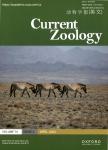Ontogenetic shifts in perceptions of safety along structural complexity gradients in a territorial damselfish
作者机构:Department of Ecology and Evolutionary Biology University of California Los Angeles CA USA
出 版 物:《Current Zoology》 (动物学报(英文版))
年 卷 期:2019年第65卷第2期
页 面:183-188页
核心收录:
学科分类:0710[理学-生物学] 07[理学] 0905[农学-畜牧学] 0906[农学-兽医学]
主 题:Stegastes nigricans habitat complexity risk assessment ontogenetic shifts antipredator behavior flight initiation distanee
摘 要:Age and body size can influence predation risk and hence habitat use. Many species undergo ontogenetic shifts in habitat use as individuals grow larger and have different age-specific predation pressures. On coral reefs, a number of fish species are more tolerant of threats in structurally complex habitats that contain more refuges than in less structurally complex habitats. However, we do not know how risk perception varies with age, and whether age interacts with habitat complexity. Adults and juveniles, because of their size, may face different risks in structurally simple versus complex habitats. We used flight initiation distanee as a metric to analyze perceptions of risk in a species of damselfish Stegastes nigricans. All else being equal, fish fleeing at greater distances are inferred to perceive higher risk. We targeted juvenile and adult damselfish to assess whether there are ontogenetic shifts in perceptions of safety in relation to structural complexity, inferred based on percent coral cover and rugosity. We found that adult damselfish tolerated closer approach in more complex habitats as measured by percent coral cover, but not rugosity, whereas juvenile fish always allowed closer approach than adult fish regardless of complexity. This ontogenetic shift in habitat use may result from juvenile fish taking bigger risks to maximize growth, whereas older animals, who are closer to their maximum body size, can afford to take fewer risks and protect their assets.



